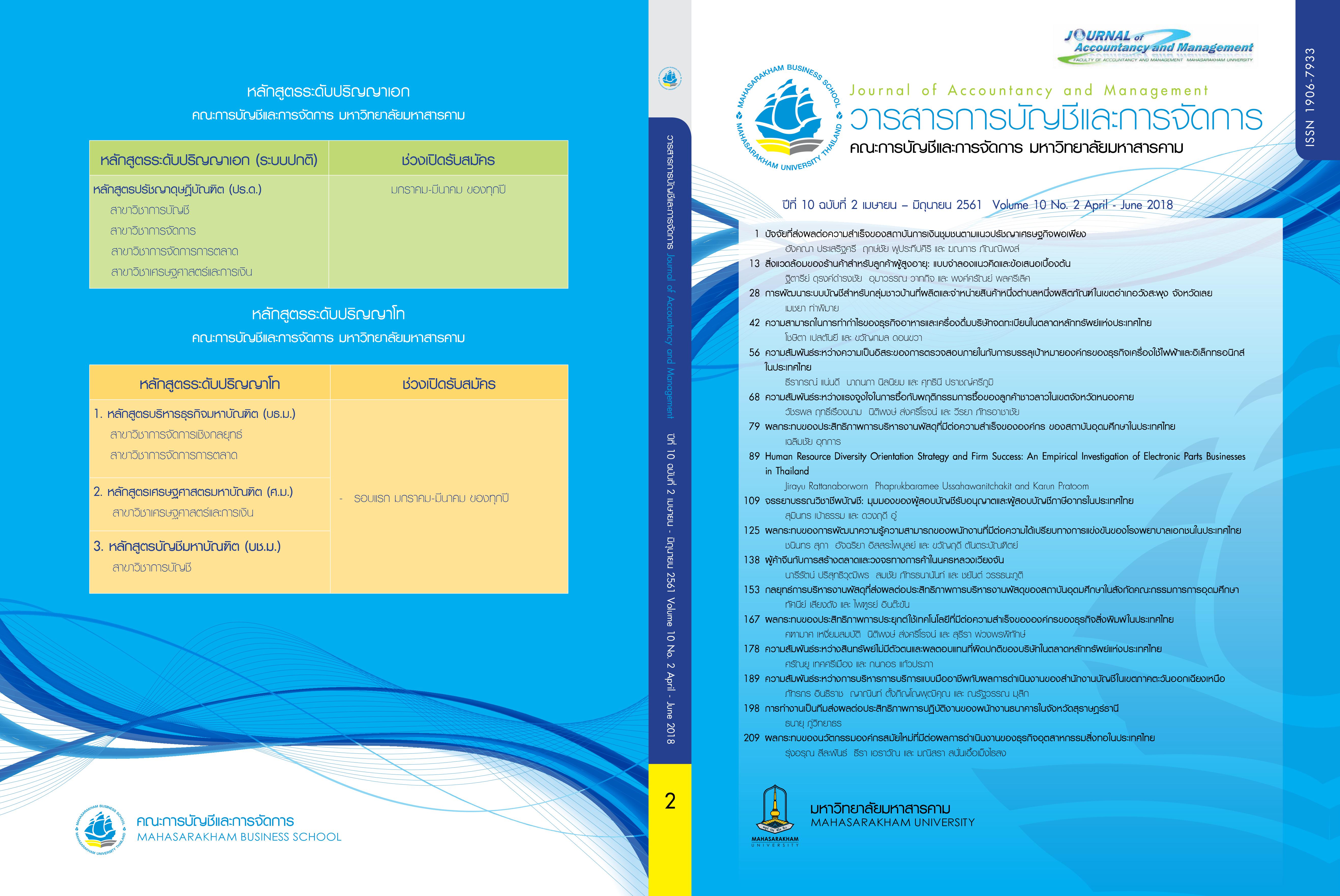Profitability of Food and Beverage Sector in the Thailand Stock Exchange
Main Article Content
Abstract
The objectives of this research were 1) to develop and validate the structural equation model of the working capital management affecting the profitability, 2) to study the importance scale the observed variables with the liquidity ratio, activity ratio, and profitability ratio, and 3) to study the impacts of the working capital management affecting the profitability. The main focus of this study was the food and beverage sector in Thailand stock exchange of 35 companies. Secondary data was quantitatively analyzed by using a structural equations modeling.
The results was shown that the model was consistent with the empirical data; χ2 = 54.366, df = 24, χ2/df = 2.27, CFI = 0.888, TLI = 0.831, IFI = 0.822, NFI = 0.892, and RMR = 0.014. Also, the results indicated that when food and beverage sector have a higher liquidity ratio and shorter of cash conversion cycle, it could increase the profitability. The management of cash conversion cycle would attempt to reduce the receivables collection period and inventory conversion period and longer payable deferral period.
Downloads
Article Details
บทความที่ได้รับการตีพิมพ์เป็นลิขสิทธิ์ของวารสารการบัญชีและการจัดการ
ข้อความที่ปรากฏในบทความแต่ละเรื่องในวารสารวิชาการเล่มนี้เป็นความคิดเห็นส่วนตัวของผู้เขียนแต่ละท่านไม่เกี่ยวข้องกับมหาวิทยาลัยมหาสารคาม และคณาจารย์ท่านอื่นๆในมหาวิทยาลัยฯ แต่อย่างใด ความรับผิดชอบองค์ประกอบทั้งหมดของบทความแต่ละเรื่องเป็นของผู้เขียนแต่ละท่าน หากมีความผิดพลาดใดๆ ผู้เขียนแต่ละท่านจะรับผิดชอบบทความของตนเองแต่ผู้เดียว
References
ตลาดหลักทรัพย์แห่งประเทศไทย. (2559). ราคาหลักทรัพย์ – ตามกลุ่มอุตสาหกรรม. ค้นเมื่อ 30 สิงหาคม 2559 จาก,
http://marketdata.set.or.th/mkt/sectorquotation.do?language=th&country=TH§or=AGRO
ศิริเพ็ญ มานะวนิชกุล. (2553). การศึกษาประสิทธิภาพการบริหารเงินทุนหมุนเวียน ประสิทธิภาพการบริหารสินทรัพย์ และความสามารถในการทำกำไร ของบริษัทจดทะเบียนในตลาดหลักทรัพย์แห่งประเทศไทย กรณีศึกษา อุตสาหกรรมแฟชั่น. การค้นคว้าอิสระปริญญามหาบัณฑิต. มหาวิทยาลัยเกษตรศาสตร์.
สมนึก เอื้อจิระพงษ์พันธ์. (2552). การบัญชีบริหาร (พิมพ์ครั้งที่ 2). กรุงเทพมหานคร : แมคกรอ-ฮิล.
สำนักงานพาณิชย์ในต่างประเทศ ณ กรุงบรัสเซลส์. (2557). แนวโน้มอุตสาหกรรมอาหารและเครื่องดื่มปี 2557. ค้นเมื่อ 25 สิงหาคม 2559, จาก http://www2.thaieurope.net/
Atseye, F. A., Ugwu, J. L., & Takon, S. M. (2015). Determinants of working capital management theoretical review. International Journal of Economics, Commerce and Management, 3(2).
Azam, M., & Haider, S. I. (2011). Impact of working capital management on firms’ performance : Evidence from non-financial institutions of KSE-30 index. Interdisciplinary Journal of Contemporary Research in Business, 3(5), 48.-492.
Benamati, J. S., & Lederer, A. L. (2008) Decision support systems unfrastructure : the root problems of the management of changing IT. Decision Support Systems, 45(4), 833–844.
Bentler, P. M., & Bonett, D. G. (1980). Significance test and goodness of fit in the analysis of covariance structures. Psychological Bulletin, 88(3), 588–606.
Brigham, E. F., & Houston, J. F. (2007). Fundamentals of financial management. USA: Thomson Corporation.Browne, M. W., & Cudeck, R. (1993). Alternative ways of assessing model fit. In: K.A.
Cavanagh, J. (2012). Management of cash and cash equivalents. Retrieved from http://tgg-accounting.com/2012/11/understanding-the-cash-conversion-cycle/
Deloof, M. (2003). Does working capital management affect profitability of Belgium firms?. Journal Business Finance and Accounting, 30, 573-588.
Egbide, B. C., Uwuigbe, O., & Uwalomwa, U. (2013). Liquidity management and profitability of manufacturing companies in Nigeria. Journal of Business and Management, 9(1), 13-21.
Gitman, L. J. (1974). Estimating corporate liquidity requirements: a simplified approach. The Financial Review,9, 79-88.
Gul, S., Khan, M. B., Rehman, S. U., Khan, M. T., Khan, M., & Khan, W. (2013). Working capital management and performance of SME sector. European Journal of Business and Management, 5(1), 60-69.
Hu, L. T., & Bentler, P. M. (1995). Evaluating model fit. In R.H. Hoyle. Structural equation modeling concepts. Thousand Oaks, California : Sage.
Jayarathne, T. (2014). Impact of working capital management on profitability : Evidence from listed companies in Sri Lanka. International Conference on Management and Economics, 3, 269-274.
Krejcie, R. V., & Morgan D. W. (1970). Determining sample size for research activities. Psycholological measurement, 607-610.
Mansoori, E., & Muhammad, J. (2012). The effect of working capital management and firm’s profitability: Evidence from Singapore. Interdisciplinary Journal of Contemporary Research in Business, 4, (September).
Marsh, H. W., & Hocevar, D. (1985). Application of confirmatory factor analysis to the study of self-concept : First- and higher order factor models and their invariance across groups. Psychological Bulletin, (97), 362-582
Nimalathasan, B. (2010). Working capital management and its impact on profitability : A study of selected listed manufacturing companies of Srilanka. Manager: information management, 12, 6-82.
Raheman, A., Talat, A., Qayyum, A., & Mohmood, A. B. (2010), Working capital management and corporate performance of manufacturing sector in Pakistan. International Research Journal of Finance and Economics, 47, 151-163
Padachi, K. (2006). Trends in working capital management and its impacts on firm’s performance: An analysis of mauritanian small manufacturing firm. International Review of Business Research Papers, 2(2), 45-58.
Paramasivan, C., & Subramanian, T. (2012). Financial management. New Age International(P) Limited. India.Pass, C. L., & Pike, R. H. (1984). An overview of working capital management and corporate financing. Managerial Finance, 10(3), 1-11.
Schumacker, R. E., & Lomax, R. G. (2010). A beginner’s guide to structural equation modeling (3rd ed.). New Jersey : Lawrence Erlbaum Associates.
Smith, K. (1987). Trade credit and informational asymmetry. Journal of Finance, 42, 863-872.
Song, Z., Liu, D., & Chen, S. (2012). Decision engineering method to identify the competitive effects of working capital : A neural network model. Systems Engineering Procedia, 5, 326-333.
Tauringana, V., & Afrifa, G. A. (2013). The relative importance of working capital management and its components to SME’s profitability. Journal of Small Business and Enterprise Development, 20(3), 453-469.
Teruel, J. G., & Solano, S. (2007). Effects of working capital management on SME profitability. International Journal of Managerial Finance, 2(3), 164-177.
Weygandt, J. J., Kimmel, P. D., & Kieso D. E. (2012). Managerial Accounting (60thed.). NJ : John Wiley & Sons.
Zubairi, H. J. (2010). Impact of working capital management and capital structure on profitability of automobile firms in Pakistan. SSRN Electronic Journal. Retrieved from
www.ssrn.com/abstract=1663354.


